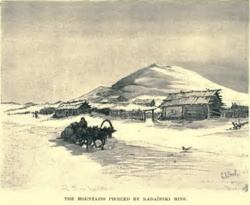Kalgansky District
Калганский район | |
|---|---|
 Kalga, 1885 | |
 Location of Kalgansky District in Zabaykalsky Krai | |
| Coordinates: 50°58′N 118°54′E / 50.967°N 118.900°E | |
| Country | Russia |
| Federal subject | Zabaykalsky Krai[1] |
| Established | December 8, 1942[1] |
| Administrative center | Kalga[1] |
| Area | |
• Total | 2,900 km2 (1,100 sq mi) |
| Population | |
• Total | 8,771 |
• Estimate (2018)[4] | 7,612 (−13.2%) |
| • Density | 3.0/km2 (7.8/sq mi) |
| • Urban | 0% |
| • Rural | 100% |
| Administrative structure | |
| • Inhabited localities[1] | 12 rural localities |
| Municipal structure | |
| • Municipally incorporated as | Kalgansky Municipal District[5] |
| • Municipal divisions[6] | 0 urban settlements, 11 rural settlements |
| Time zone | UTC+9 (MSK+6 |
| OKTMO ID | 76618000 |
| Website | http://калга.забайкальскийкрай.рф |
| 2010 Census | 8,771[3] |
|---|---|
| 2002 Census | 10,303[8] |
| 1989 Census | 13,240[9] |
| 1979 Census | 13,278[10] |
Kalgansky District (Russian: Калганский район) is an administrative[1] and municipal[5] district (raion), one of the thirty-one in Zabaykalsky Krai, Russia. It is located in the southeast of the krai and borders Nerchinsko-Zavodsky District in the north, Priargunsky District in the south, and Alexandrovo-Zavodsky District in the west. The area of the district is 2,900 square kilometers (1,100 sq mi).[2] Its administrative center is the rural locality (a selo) of Kalga.[1] As of the 2010 Census, the total population of the district was 8,771, with the population of Kalga accounting for 39.1% of that number.[3]
- ^ a b c d e f Registry of the Administrative-Territorial Units and the Inhabited Localities
- ^ a b "Encyclopedia of Zabaykalsky Krai. Entry on KalganskyDistrict" (in Russian). Transbaikal State University. Retrieved November 21, 2016.
- ^ a b c Russian Federal State Statistics Service (2011). Всероссийская перепись населения 2010 года. Том 1 [2010 All-Russian Population Census, vol. 1]. Всероссийская перепись населения 2010 года [2010 All-Russia Population Census] (in Russian). Federal State Statistics Service.
- ^ "26. Численность постоянного населения Российской Федерации по муниципальным образованиям на 1 января 2018 года". Federal State Statistics Service. Retrieved January 23, 2019.
- ^ a b Law #316-ZZK
- ^ Law #317-ZZK
- ^ "Об исчислении времени". Официальный интернет-портал правовой информации (in Russian). June 3, 2011. Retrieved January 19, 2019.
- ^ Federal State Statistics Service (May 21, 2004). Численность населения России, субъектов Российской Федерации в составе федеральных округов, районов, городских поселений, сельских населённых пунктов – районных центров и сельских населённых пунктов с населением 3 тысячи и более человек [Population of Russia, Its Federal Districts, Federal Subjects, Districts, Urban Localities, Rural Localities—Administrative Centers, and Rural Localities with Population of Over 3,000] (XLS). Всероссийская перепись населения 2002 года [All-Russia Population Census of 2002] (in Russian).
- ^ Всесоюзная перепись населения 1989 г. Численность наличного населения союзных и автономных республик, автономных областей и округов, краёв, областей, районов, городских поселений и сёл-райцентров [All Union Population Census of 1989: Present Population of Union and Autonomous Republics, Autonomous Oblasts and Okrugs, Krais, Oblasts, Districts, Urban Settlements, and Villages Serving as District Administrative Centers]. Всесоюзная перепись населения 1989 года [All-Union Population Census of 1989] (in Russian). Институт демографии Национального исследовательского университета: Высшая школа экономики [Institute of Demography at the National Research University: Higher School of Economics]. 1989 – via Demoscope Weekly.
- ^ Всесоюзная перепись населения 1979 г. Национальный состав населения по регионам России [All Union Population Census of 1979. Ethnic composition of the population by regions of Russia] (XLS). Всесоюзная перепись населения 1979 года [All-Union Population Census of 1979] (in Russian). 1979 – via Demoscope Weekly (website of the Institute of Demographics of the State University—Higher School of Economics.